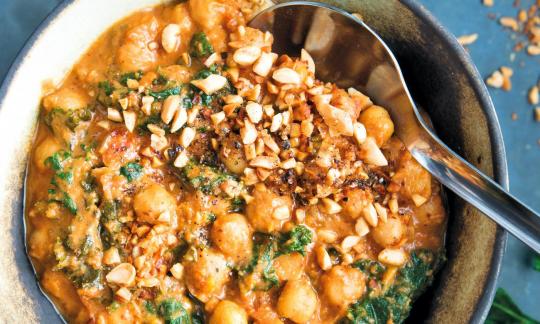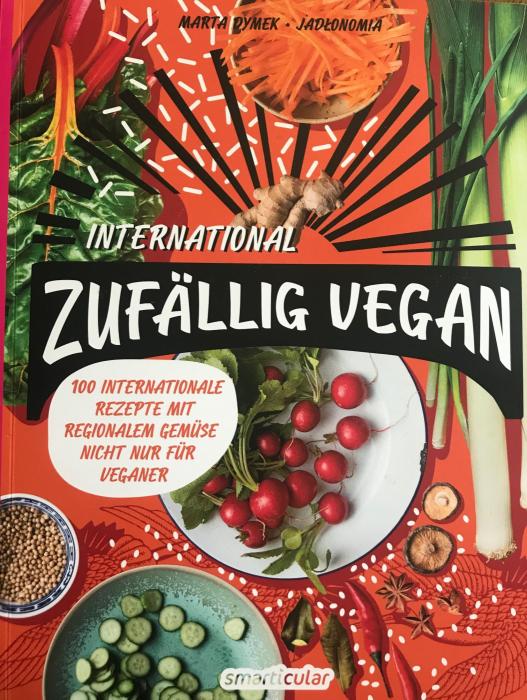Malian goulash with peanut butter
vegan
Ingredients (for servings, )
| spices for preparation | |
|---|---|
| ½ | Cinnamon stick (cinnamon stick, cinnamon, raw?, organic?) (0.14 oz) |
| 1 tsp | Cumin, seeds (raw, organic?) (0.07 oz) |
| ½ tsp | Real coriander, seeds (raw?, organic?) (0.03 oz) |
| ¼ tsp, whole | Fennel seeds, raw (organic?) (0.02 oz) |
| ¼ tsp, whole | Black pepper (organic?, raw?) (0.03 oz) |
| goulash main ingredients | |
| ½ | Onions, raw (organic?) (1.9 oz) |
| 3 cm | Ginger, raw (organic?) (1.1 oz) |
| 3 tbsp | Rapeseed oil, refined (organic?) (1.5 oz) |
| 8 ½ oz | Sweet potatoes, raw |
| 18 oz | Cooked chickpeas (organic?) |
| ¼ tsp | Chili flakes (raw?, organic?) (0.04 oz) |
| ¼ tsp | Chili powder (raw?, organic?) (0.02 oz) |
| 14 oz | Canned tomatoes (chopped, raw?, organic?) |
| 1 ½ cups | Vegetable broth without added salt (organic?) (12 oz) |
| 4 tbsp | Peanut butter (peanut puree, raw?, organic?) (2.2 oz) |
| 1 dash | Table salt (table salt, raw?, organic?) (0.01 oz) |
| 2 tbsp | Lemon juice (raw?, organic?) (0.51 oz) |
| 1 ¾ oz | Kale, raw (spring cabbage, organic?) |
Equipment
- vegetable peeler
- skillet (frying pan)
- stove
- coffee grinder, electric
- citrus juicer (lemon squeezer)
- saucepan
Type of preparation
- cook
- chop or grind
- braised
- sauté
- squeeze
- dry roast
- season to taste
- peel
Preparation
Prepare spices
Heat a medium-sized pan. Roast the spices one at a time until they start to smell intensely. Finally, put them all in the grinder and grind them (alternatively, you can roast the spices together and then grind them in a mortar).The oil should only be heated to a maximum of 180 - it should not start to smoke.
Preparation of the goulash
Peel the onion and ginger and chop roughly. Peel the sweet potatoes and dice roughly. Heat the oil in a pan and sauté the chopped onions together with the ginger for one to two minutes.Then add the sweet potatoes, drained chickpeas, chili flakes, chili powder (or cayenne pepper) and all ground spices. Sauté for one to two minutes, then add the tomatoes and simmer for three minutes.
You can also replace the canned goods (see "Alternative preparation").
finishing and serving
Add the broth, peanut butter and a pinch of salt, cover the pot and cook the stew for 18-25 minutes until the sweet potatoes are tender. Finally, add a handful of kale leaves and lemon juice and season with salt to taste.Serve with porridge or pastries.
In the original recipe, the author uses 6 tablespoons of peanut butter for 6-8 servings.
We deliberately used a vegetable broth that is low in salt (see tips).
|
Nutritional Information per person
Convert per 100g
|
2000 kcal | |
|---|---|---|
| Energy | 330 kcal | 16.5% |
| Fat/Lipids | 15 g | 21.6% |
| Saturated Fats | 2.2 g | 10.8% |
| Carbohydrates (inc.dietary fiber) | 43 g | 15.8% |
| Sugars | 7.9 g | 8.7% |
| Fiber | 13 g | 53.0% |
| Protein/Albumin | 13 g | 25.7% |
| Cooking Salt (Na:200.2 mg) | 508 mg | 21.2% |
| Essential micronutrients with the highest proportions | per person | 2000 kcal | |
|---|---|---|---|
| Vit | Vitamin K | 77 µg | 103.0% |
| Min | Manganese, Mn | 1.5 mg | 75.0% |
| Min | Copper, Cu | 0.64 mg | 64.0% |
| Vit | Vitamin A, as RAE | 439 µg | 55.0% |
| Prot | Tryptophan (Trp, W) | 0.12 g | 50.0% |
| Prot | Threonine (Thr, T, irreversibly transaminated) | 0.44 g | 48.0% |
| Vit | Vitamin B9, B11 (Folate, as the active form of folic acid) | 94 µg | 47.0% |
| Prot | Isoleucine (Ile, I) | 0.57 g | 46.0% |
| Vit | Vitamin E, as a-TEs | 5.3 mg | 44.0% |
| Elem | Potassium, K | 776 mg | 39.0% |
Detailed Nutritional Information per Person for this Recipe
The majority of the nutritional information comes from the USDA (US Department of Agriculture). This means that the information for natural products is often incomplete or only given within broader categories, whereas in most cases products made from these have more complete information displayed.
If we take flaxseed, for example, the important essential amino acid ALA (omega-3) is only included in an overarching category whereas for flaxseed oil ALA is listed specifically. In time, we will be able to change this, but it will require a lot of work. An “i” appears behind ingredients that have been adjusted and an explanation appears when you hover over this symbol.
For Erb Muesli, the original calculations resulted in 48 % of the daily requirement of ALA — but with the correction, we see that the muesli actually covers >100 % of the necessary recommendation for the omega-3 fatty acid ALA. Our goal is to eventually be able to compare the nutritional value of our recipes with those that are used in conventional western lifestyles.
| Essential fatty acids | per person | 2000 kcal |
|---|---|---|
| Alpha-Linolenic acid; ALA; 18:3 omega-3 | 0.72 g | 36.0% |
| Linoleic acid; LA; 18:2 omega-6 | 3.5 g | 35.0% |
| Essential amino acids | per person | 2000 kcal |
|---|---|---|
| Tryptophan (Trp, W) | 0.12 g | 50.0% |
| Threonine (Thr, T, irreversibly transaminated) | 0.44 g | 48.0% |
| Isoleucine (Ile, I) | 0.57 g | 46.0% |
| Lysine (Lys, K, irreversibly transaminated) | 0.70 g | 38.0% |
| Phenylalanine (Phe, F) | 0.58 g | 38.0% |
| Leucine (Leu, L) | 0.86 g | 35.0% |
| Valin (Val, V) | 0.54 g | 33.0% |
| Methionine (Met, M) | 0.14 g | 15.0% |
| Vitamins | per person | 2000 kcal |
|---|---|---|
| Vitamin K | 77 µg | 103.0% |
| Vitamin A, as RAE | 439 µg | 55.0% |
| Vitamin B9, B11 (Folate, as the active form of folic acid) | 94 µg | 47.0% |
| Vitamin E, as a-TEs | 5.3 mg | 44.0% |
| Vitamin B6 (pyridoxine) | 0.46 mg | 33.0% |
| Vitamin C (ascorbic acid) | 22 mg | 28.0% |
| Vitamin B3 (Niacin) | 4.5 mg | 28.0% |
| Vitamin B7 (Biotin, ex vitamin H) | 12 µg | 24.0% |
| Vitamin B1 (Thiamine) | 0.25 mg | 23.0% |
| Vitamin B5 (Pantothenic acid) | 1.0 mg | 17.0% |
| Vitamin B2 (Riboflavin) | 0.17 mg | 12.0% |
| Essential macroelements (macronutrients) | per person | 2000 kcal |
|---|---|---|
| Potassium, K | 776 mg | 39.0% |
| Phosphorus, P | 243 mg | 35.0% |
| Magnesium, Mg | 104 mg | 28.0% |
| Sodium, Na | 200 mg | 25.0% |
| Calcium, Ca | 116 mg | 15.0% |
| Essential trace elements (micronutrients) | per person | 2000 kcal |
|---|---|---|
| Manganese, Mn | 1.5 mg | 75.0% |
| Copper, Cu | 0.64 mg | 64.0% |
| Iron, Fe | 4.3 mg | 30.0% |
| Zinc, Zn | 1.9 mg | 19.0% |
| Iod, I (Jod, J) | 9.5 µg | 6.0% |
| Selenium, Se | 1.8 µg | 3.0% |
| Fluorine, F | 14 µg | < 0.1% |
Randomly Vegan International: 100 international recipes with regional vegetables – not just for vegans. Unusual yet easy-to-prepare dishes.
Since this book is written in German, a description is omitted here. If you are interested, please switch to German in the menu.
The Malian goulash "Maafe" with peanut butter smells deliciously of cumin and cinnamon. Depending on the region of Africa, the vegetables and liquid used in this traditional dish vary.
The preparation time indicated does not include cooking the chickpeas. The time refers to using canned chickpeas or previously pre-cooked chickpeas.
Nutrient profile: According to GDA guidelines, one portion of this recipe covers more than 85% of the daily requirement of vitamin K and 75% of the daily requirement of manganese, which plays a role in the formation of cartilage tissue. The essential amino acids tryptophan, threonine and isoleucine as well as vitamin A and folic acid are covered by almost 50%. The ratio of omega-6 to omega-3 fatty acids is 6:1, just above the recommended maximum ratio of 5:1.
Chickpeas: Chickpeas are very high in protein, with an average of 20 g of protein per 100 g, and are therefore a good addition to vegetables. Chickpeas (like many pulses) are usually available in dried or pre-cooked and preserved form. While the preserved version is of course more convenient and saves time, the dried version, which you have to cook yourself, has the advantage of tasting much better.
Sweet potatoes: Sweet potatoes, also called sweet potatoes, are not actually potatoes. Although they grow as tubers in the ground, they are not part of the nightshade family. The tubers have a high water content and cannot be stored as long as conventional potatoes, but their shelf life can be increased by careful handling, such as avoiding bruising.
Cumin: Due to the similar name, there is often confusion between cumin and caraway. However, they are not closely related and also differ greatly in taste.
Coriander seeds: Coriander seeds are spherical and have a bitter-spicy to sweet aroma. Ground coriander does not keep for long due to the high essential oil content.
Fennel seeds: Fennel seeds contain essential oils. These include anethole, fenchone and estragole. Anethole soothes the stomach and has an antispasmodic effect. It is also mainly responsible for the typical aniseed taste and is also found in anise and star anise.
Peanut butter: In general, you should look for a product that is as close to natural as possible. This means no flavor enhancers, no added sugar and as little salt as possible. It is also better to take a look at the nutritional composition rather than just looking at the product name. For example, the "low-salt" peanut still has almost 10 times as much salt as the one without added salt.
Frying oil: We chose refined rapeseed oil as our frying oil. Rapeseed oil has a high proportion of essential fatty acids, especially omega-3 fatty acids.
Cook chickpeas yourself: Soak the chickpeas in plenty of fresh water for at least 12 hours or overnight, but preferably 24 hours. Chickpeas absorb a lot of water - you should bear this in mind when choosing the container and the amount of water. Then drain the chickpeas through a sieve and rinse briefly. Put in a large pot and cook in plenty of water. The cooking time depends on the age and storage of the chickpeas and is around 1.5 - 2 hours - it is best to plan generously when preparing chickpeas.
Buying preserved chickpeas: For a quick option, it is advisable to only buy organic quality canned goods. They are often processed more gently, but above all they contain fewer or no additives. Glass canned goods, which generally predominate in organic stores, are particularly recommended. These do not contain aluminum or BPA (bisphenol A) and are more environmentally friendly.
Reduce salt and oil: We have deliberately used extra low-salt vegetable stock to keep the salt content as low as possible without compromising on taste. Since salt requirements vary from person to person, it is best for you to decide for yourself. We have also reduced the amount of oil by half. A good read on this topic is the book " Salt. Sugar, Fat ".
We have deliberately reduced the amount of peanut butter to 4 tablespoons to slightly improve the ratio of omega-6 to omega-3 fatty acids. However, you can also use the full 6 tablespoons, it's up to you.
Prepare fresh: We generally recommend using fresh, home-cooked ingredients. You can use fresh tomatoes instead of canned tomatoes. You can easily pre-cook the chickpeas yourself (see tips). By cooking them at home, you can also determine the firmness yourself (canned chickpeas are often very soft, sometimes mushy). Of course, canned goods often contain unnecessary additives or are heavily salted, so you should prefer the unprocessed version.
Using leftovers: This stew is an easy way to use up leftover vegetables in the fridge. You can also use carrots or parsley and chopped cabbage instead of kale.






